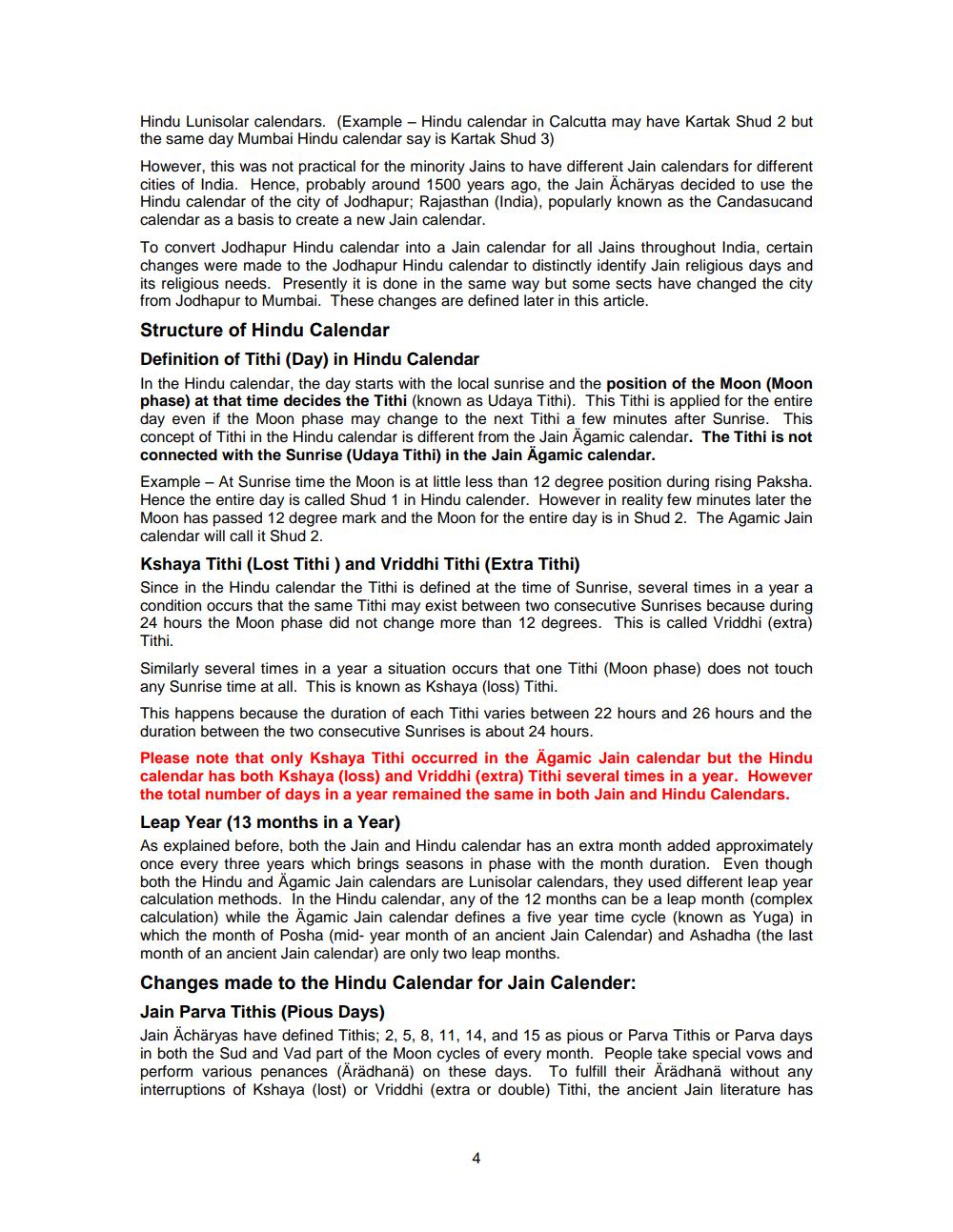Book Title: Historical Perspective of Samvatsari Day and Jain Calendar Author(s): Pravin K Shah Publisher: JAINA Education Committee View full book textPage 4
________________ Hindu Lunisolar calendars. (Example - Hindu calendar in Calcutta may have kartak Shud 2 but the same day Mumbai Hindu calendar say is Kartak Shud 3) However, this was not practical for the minority Jains to have different Jain calendars for different cities of India. Hence, probably around 1500 years ago, the Jain Acharyas decided to use the Hindu calendar of the city of Jodhapur; Rajasthan (India), popularly known as the Candasucand calendar as a basis to create a new Jain calendar. To convert Jodhapur Hindu calendar into a Jain calendar for all Jains throughout India, certain changes were made to the Jodhapur Hindu calendar to distinctly identify Jain religious days and its religious needs. Presently it is done in the same way but some sects have changed the city from Jodhapur to Mumbai. These changes are defined later in this article. Structure of Hindu Calendar Definition of Tithi (Day) in Hindu Calendar In the Hindu calendar, the day starts with the local sunrise and the position of the Moon (Moon phase) at that time decides the Tithi (known as Udaya Tithi). This Tithi is applied for the entire day even if the Moon phase may change to the next Tithi a few minutes after Sunrise. This concept of Tithi in the Hindu calendar is different from the Jain Agamic calendar. The Tithi is not connected with the Sunrise (Udaya Tithi) in the Jain Agamic calendar. Example - At Sunrise time the Moon is at little less than 12 degree position during rising Paksha. Hence the entire day is called Shud 1 in Hindu calender. However in reality few minutes later the Moon has passed 12 degree mark and the Moon for the entire day is in Shud 2. The Agamic Jain calendar will call it Shud 2. Kshaya Tithi (Lost Tithi ) and Vriddhi Tithi (Extra Tithi) Since in the Hindu calendar the Tithi is defined at the time of Sunrise, several times in a year a condition occurs that the same Tithi may exist between two consecutive Sunrises because during 24 hours the Moon phase did not change more than 12 degrees. This is called Vriddhi (extra) Tithi. Similarly several times in a year a situation occurs that one Tithi (Moon phase) does not touch any Sunrise time at all. This is known as Kshaya (loss) Tithi. This happens because the duration of each Tithi varies between 22 hours and 26 hours and the duration between the two consecutive Sunrises is about 24 hours. Please note that only Kshaya Tithi occurred in the Agamic Jain calendar but the Hindu calendar has both Kshaya (loss) and Vriddhi (extra) Tithi several times in a year. However the total number of days in a year remained the same in both Jain and Hindu Calendars. Leap Year (13 months in a Year) As explained before, both the Jain and Hindu calendar has an extra month added approximately once every three years which brings seasons in phase with the month duration. Even though both the Hindu and Agamic Jain calendars are Lunisolar calendars, they used different leap year calculation methods. In the Hindu calendar, any of the 12 months can be a leap month (complex calculation) while the Agamic Jain calendar defines a five year time cycle (known as Yuga) in which the month of Posha (mid-year month of an ancient Jain Calendar) and Ashadha (the last month of an ancient Jain calendar) are only two leap months. Changes made to the Hindu Calendar for Jain Calender: Jain Parva Tithis (Pious Days) Jain Ächärvas have defined Tithis: 2, 5, 8, 11, 14, and 15 as pious or Parva Tithis or Parva days in both the Sud and Vad part of the Moon cycles of every month. People take special vows and perform various penances (Ärädhanä) on these days. To fulfill their Ärädhanä without any interruptions of Kshaya (lost) or Vriddhi (extra or double) Tithi, the ancient Jain literature hasPage Navigation
1 2 3 4 5 6 7 8 9 10 11
